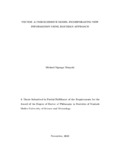| dc.description.abstract | The Vector Autoregressive (VAR) Models have been applied extensively in many
fields ranging from finance, economics, machine learning among others. In fact,
the VAR models are the mostly applied among the multivariate time series models
since they have shown to perform well especially when forecasting is done. Many
researchers have fitted the VAR models to the available data so as to come up with
a model that explains the relationship between the variables involved. However,
despite this fact that the VAR models have performed well, there is a concern of
what one should do in the event that new information is received after the model
has been fitted. In this study, an approach is provided of updating the VAR
model instead of fitting a new model whenever new information is received where
the fitted VAR model is treated as the prior, new information or measurements
as the likelihood to get an updated VAR model, the posterior, using the Bayesian
Approach. Thus, updated VAR models of order one, two and three are developed
after which generalization is done to a VAR model of order p. The performance
of the existing VAR model is compared with the updated VAR model from which
it is observed that the model performs well based on the fairly low values of root
mean square error (RMSE) obtained. Furthermore, estimation of parameters is
done using the joint estimation which estimates both the states and the parameters
simultaneously. In the estimation, the estimated parameters converge to
the true parameter value as time evolves. An application is considered where a
penta-variate VAR(1) model is fitted using data for the contribution of five main
sub-sectors of the agriculture sector to the Kenyan economy. The data considered
was obtained from the Kenya National Bureau of Statistics (KNBS) on Statistical
abstract reports from 2000 - 2021. The model was then updated and after comparing
with the initial model, the model was found to perform well based on the
lower values of the RMSE. From the study, it is then concluded that the updated
Vector Autoregressive model performs well based on the Root Mean Square Error
(RMSE). Finally, recommendations are also given regarding future work of updating
other multivariate time series models to assimilate new information obtained
after model fitting is done. | en_US |

